英语作文教学案例
让英语作文绽放靓丽的色彩——《高中英语写作课》教学案例

prns rn s rh os④ Ho ee,h e etg fh os aet ak eby. ” o f t w vr te r nae e y pc ot b
⑥ Asfr sf,HelnKelri myio e a s adyc nI e o my l l d l c u eh r l a e e s b
a d l ,wh l % o h o s f ur p r t r.( As t e d t s i os i 48 e ft e b y g e s o t sa s i s h aa
s o s “ a e t”r n s h e o dfr 1 i s b tt s h u t a h w . p rn s a k es c n egr . u e o rht t t o n l ii t f h
c m eas c sf lp r o i hewo l. o uc e su e s n t rd n Stp4. e tv —wo k e Cr a ie r
英语写作要求考 生根据所给情景和要求, 自己的语言 , 用 组 织成一篇内容充 实 、 句子连贯 、 用词贴切的作文 , 然而在教 和学 的 实践 中达到这个要求却并不容易。 写作 已经是中学英语教学中的 重头戏 , 更是高考的重点和难点。
强 句子 表 现 力 。
Se . u tp 5 S mma y T F o wh t i u tn w,w a a o r : : r m a d d j s o we h t ny u c
s um p t, ieac u owrt omp sto ? o i n i
“
Se 6 Ho wo k W r eac mp s in a o t h h n e f o r tp . me r : i o o i o b u ec a g so u t t t y h meo o twn, sn ew i n c n q e a ela n d i i ca s u i g h rt g e h i u s t i t weh v r e t s ls e nh
高中英语书面表达教学设计案例
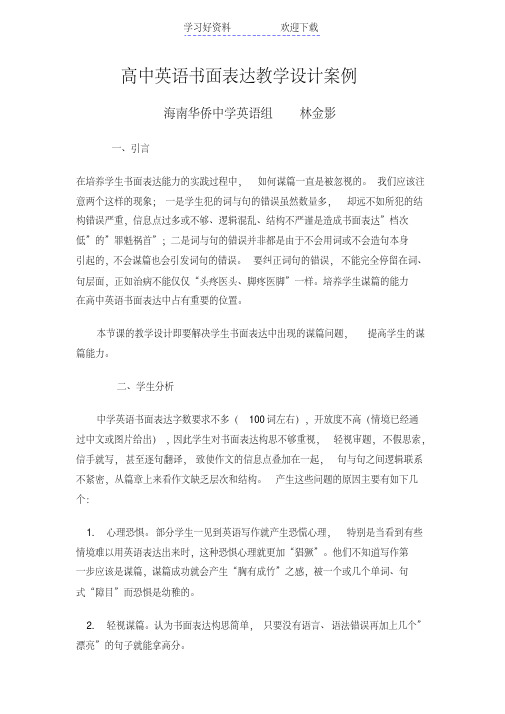
高中英语书面表达教学设计案例海南华侨中学英语组林金影一、引言在培养学生书面表达能力的实践过程中,如何谋篇一直是被忽视的。
我们应该注意两个这样的现象;一是学生犯的词与句的错误虽然数量多,却远不如所犯的结构错误严重,信息点过多或不够、逻辑混乱、结构不严谨是造成书面表达”档次低”的”罪魁祸首”;二是词与句的错误并非都是由于不会用词或不会造句本身引起的,不会谋篇也会引发词句的错误。
要纠正词句的错误,不能完全停留在词、句层面,正如治病不能仅仅“头疼医头、脚疼医脚”一样。
培养学生谋篇的能力在高中英语书面表达中占有重要的位置。
本节课的教学设计即要解决学生书面表达中出现的谋篇问题,提高学生的谋篇能力。
二、学生分析中学英语书面表达字数要求不多(100词左右),开放度不高(情境已经通过中文或图片给出),因此学生对书面表达构思不够重视,轻视审题,不假思索,信手就写,甚至逐句翻译,致使作文的信息点叠加在一起,句与句之间逻辑联系不紧密,从篇章上来看作文缺乏层次和结构。
产生这些问题的原因主要有如下几个:1.心理恐惧。
部分学生一见到英语写作就产生恐慌心理,特别是当看到有些情境难以用英语表达出来时,这种恐惧心理就更加“猖獗”。
他们不知道写作第一步应该是谋篇,谋篇成功就会产生“胸有成竹”之感,被一个或几个单词、句式“障目”而恐惧是幼稚的。
2.轻视谋篇。
认为书面表达构思简单,只要没有语言、语法错误再加上几个”漂亮”的句子就能拿高分。
3.不懂谋篇。
不知道写作的主旨意图,以为写作就是要完成教师布置的任务。
三、目标分析本节书面表达教学课,就是要解决学生书面表达过程中谋篇时出现的问题,培养学生谋篇的习惯,学习和掌握谋篇的策略。
具体说来,应当达成如下几个目标:1.认知目标:通过分析学生书面表达过程中存在的问题,使学生了解谋篇的重要性。
2.培养谋篇习惯目标:通过两篇书面表达的实际演练,使学生养成写作前先谋篇的习惯。
3.掌握谋篇策略目标:通过“脑力震荡”和教师指点,使学生掌握谋篇的步骤,了解谋篇的要求。
初中英语作文教案

初中英语作文教案一、教学目标:1.能够掌握基本的英语作文写作技巧;2.能够运用所学知识,写出简单、连贯、有逻辑的英语作文;3.培养学生的英语写作兴趣,提高写作能力。
二、教学重点:1.培养学生的写作兴趣;2.教授基本的英语写作技巧;3.激发学生的写作创造力。
三、教学难点:1.如何培养学生的写作兴趣;2.如何激发学生的写作创造力。
四、教学内容:1.教师引导学生阅读范文,分析范文结构、语言表达等;2.教师讲解英语作文写作技巧,如句型搭配、词汇运用等;3.教师指导学生进行写作训练,如写作练习、写作指导等;4.教师布置作业,让学生在家继续练习写作。
五、教学过程:1.教师引导学生阅读范文,分析范文结构、语言表达等,激发学生的写作兴趣;2.教师讲解英语作文写作技巧,如句型搭配、词汇运用等,提高学生的写作能力;3.教师指导学生进行写作训练,如写作练习、写作指导等,培养学生的写作技能;4.教师布置作业,让学生在家继续练习写作,巩固所学知识。
六、教学方法:1.导入法,通过引导学生阅读范文,激发学生的写作兴趣;2.讲授法,通过讲解英语作文写作技巧,提高学生的写作能力;3.示范法,通过指导学生进行写作训练,培养学生的写作技能;4.作业法,通过布置作业,巩固所学知识,提高学生的写作水平。
七、教学手段:1.多媒体课件,用于展示范文、写作技巧等;2.教学实物,如英语作文书籍、写作范文等;3.黑板报,用于记录重点、难点内容,帮助学生复习。
八、教学检查与评价:1.教师在课堂上进行实时检查,发现学生写作中的问题并及时纠正;2.教师在课后进行作业批改,对学生的写作进行评价,指导学生改进。
九、教学反思:1.教师要及时调整教学方法,根据学生的实际情况进行针对性教学;2.教师要注重培养学生的写作兴趣,激发学生的写作热情;3.教师要关注学生的写作能力提高情况,及时进行评价和指导。
初中英语作文教案到此结束,希望本教案能够帮助到广大英语教师,提高学生的写作水平。
英语写作教学教案

英语写作教学教案【篇一:初三英语写作公开课课教案】初三英语写作公开课课教学设计双沙中学李育新 2011.6.2课型:专题复习课教学内容:初三英语书面表达专题复习教学目标: 1.指导学生掌握书面表达语篇结构的组织技巧。
2.帮助学生学会使用常用的连接词、过渡词和过渡句,提高文章的连贯性。
3.培养学生在有限的时间内快速构思、罗列提纲的能力。
4. 指导学生小组合作评改学生习作。
教学重点: 1.帮助学生学会使用常用的连接词、过渡词和过渡句,提高文章的连贯性。
2. 培养学生在有限的时间内快速构思、罗列提纲及扩展成文的能力教学难点:1.帮助学生学会使用常用的连接词、过渡词和过渡句,提高文章的连贯性。
2. 培养学生在有限的时间内快速构思、罗列提纲及扩展成文的能力讨论法教学方法:自主学习,合作学习教学辅助手段:电脑(或实物投影仪)学情分析:1. 书面表达是写的一种途径,是英语交际的重要组成部分。
初中阶段对于英语写作的要求,实际上是“有指导的写作”(guided writing)。
它通过提供情景(文字、图画、表格),让学生用学过的英语语言来描述事物或事件并表达一定的思想,以此达成和检验对所学英语语言知识的实践应用能力。
客观地说,书面表达一直是我们英语教学的一个难点,也是学生应试的一个难点。
从中考英语试卷的抽样调查情况来看,英语写作是得分最为薄弱的一个题项。
究其原因,一是学生写作练习的时间少,二是教师平时缺乏对学生进行系统的写作知识的指导。
(比如,如何用词、句、组段、谋篇等)。
这些原因造成了学生从最初不会写盲目写到不愿写。
惧怕写,直至最后拒绝写的恶性循环。
2. 学生分析我校学生生源较差,学生英语学习两级分化严重,因此尽管经过3年的学习与训练,仍有相当一部分学生作文得分在6-7分之间甚至更低。
书面表达中式英语较多,连贯性较差。
很多学生对书面表达中快速构思和罗列提纲能力较差。
本堂课希望通过指导、帮助提高学生学会使用常用的连接词、过渡词和过渡句,提高文章的连贯性,帮助学生在有限的时间内快速构思、罗列提纲能力。
教学案例反思英语作文
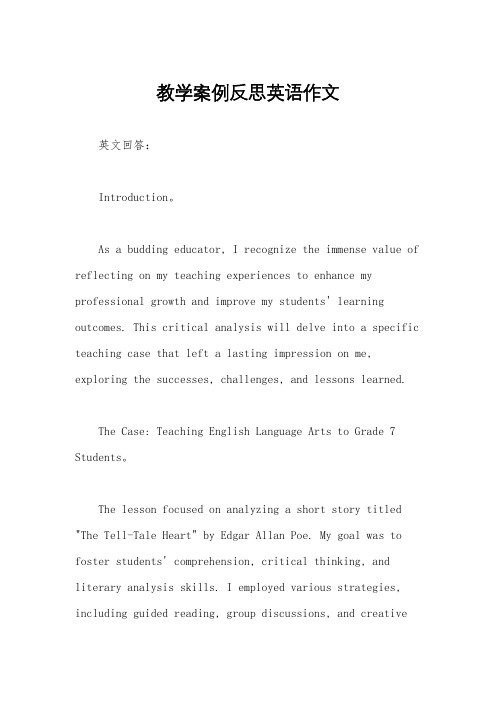
教学案例反思英语作文英文回答:Introduction。
As a budding educator, I recognize the immense value of reflecting on my teaching experiences to enhance my professional growth and improve my students' learning outcomes. This critical analysis will delve into a specific teaching case that left a lasting impression on me, exploring the successes, challenges, and lessons learned.The Case: Teaching English Language Arts to Grade 7 Students。
The lesson focused on analyzing a short story titled "The Tell-Tale Heart" by Edgar Allan Poe. My goal was to foster students' comprehension, critical thinking, and literary analysis skills. I employed various strategies, including guided reading, group discussions, and creativewriting activities.Successes。
Engaging Lesson Design: By incorporating diverse learning activities, such as character mapping, symbolism identification, and group presentations, I kept students engaged and motivated throughout the lesson.Improved Comprehension: The guided reading approach facilitated students' understanding of the complex text. They were able to identify the main characters, infer motivations, and explore the author's literary devices.Critical Thinking Development: Through group discussions, students exchanged ideas, defended their interpretations, and developed nuanced perspectives on the story's themes. 。
初中英语作文写作技巧指导教学设计案例
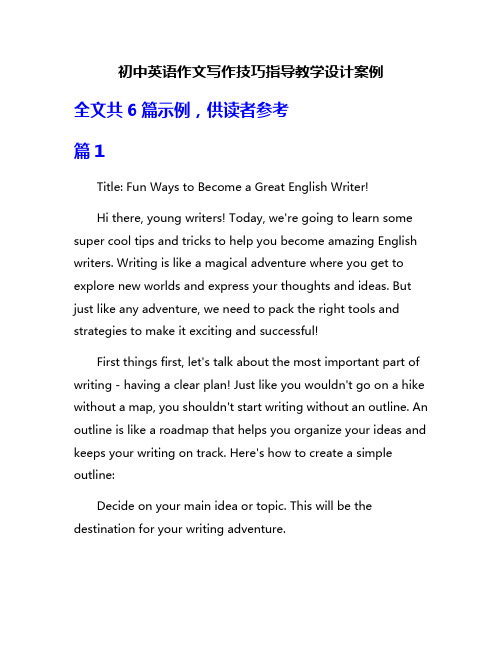
初中英语作文写作技巧指导教学设计案例全文共6篇示例,供读者参考篇1Title: Fun Ways to Become a Great English Writer!Hi there, young writers! Today, we're going to learn some super cool tips and tricks to help you become amazing English writers. Writing is like a magical adventure where you get to explore new worlds and express your thoughts and ideas. But just like any adventure, we need to pack the right tools and strategies to make it exciting and successful!First things first, let's talk about the most important part of writing - having a clear plan! Just like you wouldn't go on a hike without a map, you shouldn't start writing without an outline. An outline is like a roadmap that helps you organize your ideas and keeps your writing on track. Here's how to create a simple outline:Decide on your main idea or topic. This will be the destination for your writing adventure.Brainstorm supporting details or examples. These will be the pit stops along the way.Arrange your supporting details in a logical order. This will be your route.Add an introduction and conclusion. These are like the starting and ending points of your journey.With your outline in hand, you're ready to start writing! But wait, there's more! Let's talk about making your writing interesting and engaging.One way to do this is by using vivid descriptions. Imagine you're painting a picture with your words. Use adjectives (describing words) to add color and detail to your writing. For example, instead of saying "the dog," you could say "the fluffy, energetic golden retriever."Another way to make your writing pop is by using strong verbs. Verbs are action words, and they can really bring your writing to life. Instead of saying "she walked," you could say "she sprinted" or "she tiptoed."Don't forget about adding personal experiences, examples, and anecdotes to your writing. These little stories and details willhelp your readers connect with your ideas and make your writing more relatable and memorable.Of course, no great adventure is complete without a few challenges along the way. When it comes to writing, one of the biggest challenges is revising and editing your work. But don't worry, we've got some tips to make it easier!First, try reading your writing out loud. This can help you catch mistakes and awkward phrasing that you might have missed while reading silently. You can also ask a friend or family member to read your writing and provide feedback.Another helpful strategy is to take a break from your writing and come back to it with fresh eyes. Sometimes, stepping away for a little while can give you a new perspective and help you spot areas that need improvement.Finally, don't be afraid to seek help from your teacher or a writing tutor. They're like expert guides who can offer valuable advice and support to help you become a better writer.Writing may seem like a daunting task at first, but with practice and these handy tips, you'll be embarking on amazing writing adventures in no time! Remember, every great writerstarted somewhere, and with hard work and dedication, you too can become a master storyteller and wordsmith.So grab your pen (or keyboard), pack your outline, and let's hit the trail to writing success! Happy writing, adventurers!篇2Title: Super Cool Tips for Writing Awesome English Essays!Hi friends! Are you a middle school student who struggles with writing English essays? Don't worry, I've got your back! As a wise old elementary school kid, I've learned some really neat tricks to help make essay writing easier and way more fun. Get ready to become an essay master!First up, let's talk about picking a totally rad topic. Your teacher might assign you a subject, but sometimes you get to choose whatever you want to write about. If that's the case, pick something you're really interested in and excited to discuss. Maybe you're obsessed with video games, or perhaps you can't get enough of dinosaurs or candy. Whatever floats your boat! Writing about stuff you love makes the whole process a million times more enjoyable.Once you've nailed down your subject, it's time to get those brilliant ideas flowing. Spend some time brainstorming everything you can think of related to your topic. Don't hold back! Write down anything and everything that pops into your head, even if it seems silly at first. You can sort out the good ideas from the wacky ones later.Now that you've got a jumping off point, you'll want to organize all those amazing thoughts into a solid plan. This is where the classic five paragraph essay structure comes in handy. That's an intro paragraph to get things started, three jam-packed body paragraphs to explore your key points, and a high-impact conclusion to leave your reader wowed. Mapping out your ideas into an outline makes putting the actual essay together a total breeze.Okay, time to dive into the writing itself! Don't be intimidated by staring at that blank page. Just take itstep-by-step, section-by-section. Start with a hook in your intro to grab the reader's attention right away. You could ask a thought-provoking question, share an interesting fact, or tell a funny joke related to your topic. Anything to pique their curiosity! Then, preview the main points you'll cover in the essay so your reader knows what to expect.Each of your body paragraphs needs to focus on one of the key ideas from your outline. Kick things off with a strong topic sentence that states the main point you'll explore. Then back it up with lots of juicy examples, details, facts, quotes, or personal experiences to make your case. Don't just tell, show with vivid descriptions to pull your reader into the action! Also, make sure to analyze and explain why the evidence you provide supports your point.Once you've unpacked all your main points, it's time to bring it on home with your conclusion. This is the perfect opportunity to reinforce why your topic is so fascinating and drive your message home one last time. You could restate your key ideas, add a thought-provoking question for readers to ponder, share a personal anecdote that sums things up, or challenge your audience to take some sort of action. Just avoid introducing any brand new concepts. A conclusion should provide a sense of closure and circular back to your hook.Through each step, always keep your reader in mind. Your essay should flow smoothly with clear transitions between sentences and paragraphs to help your audience easily follow along. Use a variety of sentences structures and vocabulary words to keep things interesting, but don't go overboard withcomplex terms that could confuse your reader. The goal is to explain your thoughts in a straightforward, engaging way.I know, I know... you're probably wondering about pesky things like grammar, spelling, and mechanics. Those are definitely important, but don't get bogged down worrying about every little detail on your first draft. Just get your ideas out onto the page first. You can always revise and polish things up later. Reading your essay aloud can really help you catch and fix any awkward phrasing or errors.Last but not least, don't forget to give your essay an awesome title! Choose something catchy that sums up your main idea and makes readers curious to dive in.And there you have it, all my top tips for crafting an A+ English essay. Just take it one step at a time, stay organized, write about something you're pumped about, and pour your personality onto the page. Before you know it, you'll be churning out killer essays left and right!So what are you waiting for? Grab a snazzy notebook, your favorite pencil or computer, and get to brainstorming that next masterpiece. You've got this!Happy writing, rock stars!篇3Title: Tips for Writing Awesome English Compositions!Hey there, fellow students! Are you struggling with writing compositions in your English class? Don't worry; I've got some super-cool tips to share with you. Writing can be a lot of fun once you get the hang of it, and with these tricks up your sleeve, you'll be impressing your teachers and classmates in no time!First things first, let's talk about the most important part of any composition – the topic! Choosing an interesting and exciting topic is key to keeping your readers engaged from start to finish. Don't just pick something boring like "My Summer Vacation" or "My Favorite Food." Instead, think about things that fascinate you or make you curious. Maybe you're really into dinosaurs, or you love exploring space and the mysteries of the universe. Whatever your passion is, let that shine through in your topic choice.Next up, we've got the introduction. This is where you'll hook your readers and give them a sneak peek of what's to come.A great way to start is by asking a thought-provoking question or sharing an interesting fact related to your topic. For example, if you're writing about dinosaurs, you could ask, "Did you knowthat the Tyrannosaurus Rex had teeth as big as bananas?" Or, if you're writing about space exploration, you could share amind-blowing statistic like, "There are more stars in the universe than grains of sand on all the beaches of the world." See? Now you've got your readers' attention!Once you've got them hooked, it's time to dive into the body paragraphs. This is where you'll flesh out your ideas and support them with juicy details and examples. Remember, each paragraph should focus on one main idea, and you'll want to use transition words (like "firstly," "additionally," and "moreover") to help your writing flow smoothly from one point to the next.Don't forget to back up your claims with evidence! If you're writing about dinosaurs, you could include facts and figures from reliable sources, like museums or science websites. If you're writing about space, you might want to quote famous astronauts or include snippets from NASA reports. The more specific and concrete your examples are, the stronger your composition will be.Now, let's talk about something that can make or break your composition: vocabulary! Using a variety of interesting and descriptive words can really bring your writing to life. Instead of saying something is "big," you could call it "colossal" or"gargantuan." Instead of saying something is "cool," you could describe it as "fascinating" or "captivating." The more colorful your language, the more engaging your composition will be.But be careful – you don't want to overdo it with big, fancy words that you don't fully understand. That's a surefire way to confuse your readers and undermine your credibility. Stick to words you're comfortable with, and if you're unsure about the meaning or usage of a word, look it up or ask your teacher for guidance.As you're nearing the end of your composition, it's time to start thinking about your conclusion. This is where you'll wrap everything up and leave your readers with a lasting impression. A great conclusion should summarize your main points and tie everything together in a neat little bow. You might also want to include a thought-provoking question or a call to action that encourages your readers to think more deeply about the topic.Finally, don't forget to proofread, proofread, proofread! Even the best writers make mistakes, so it's crucial to go over your work with a fine-toothed comb. Check for spelling and grammar errors, as well as any awkward phrasing or unclear sentences. You might even want to read your composition out loud to catch any areas that sound clunky or confusing.And there you have it, my friends – the secret sauce to writing amazing English compositions! Remember, practice makes perfect, so don't be discouraged if your first few attempts aren't masterpieces. Keep writing, keep learning, and keep having fun with it. Before you know it, you'll be a composition-writing pro!篇4Writing Great English Essays in Middle School - A Kid's GuideHey everyone! Are you a middle schooler who has to write essays in English class? I know it can seem really hard and boring at first. But don't worry, I'm going to share some tips that will help make your essay writing much easier and way more fun!First off, let's talk about getting started on your essay. The very first step is to carefully read the instructions or prompt your teacher gives you. What is the essay supposed to be about? What kind of essay do you need to write - persuasive, narrative, expository? Knowing this will help guide the whole process.Once you know the topic and type of essay, it's time to start brainstorming ideas! Get a piece of paper or open a document on your computer and just start writing down anything that comes to mind about the topic. Don't worry about completesentences or organization yet, just get all your thoughts out there. You can use diagrams or make lists too if that helps spark ideas.After brainstorming, start sorting through and organizing your ideas into an outline. This will be the road map for your essay. A solid outline has an introduction paragraph, body paragraphs with supporting details, and a conclusion paragraph. Each body paragraph should have one clear main idea.Okay, now for some tips on actually writing the essay itself! The introduction paragraph needs to grab the reader's attention right away with an interesting hook. This could be a question, fun fact, or bold statement related to your topic. Then, introduce what your essay will be about and wrap it up with a clear thesis statement.Next up are the body paragraphs, where you'll lay out all your supporting points and evidence for your thesis. A good trick is to start each body paragraph with a topic sentence that sums up the main idea you'll cover. Then use examples, facts, explanations and analysis to back that point up. Don't forget to include transitions between paragraphs to help everything flow smoothly.For the conclusion paragraph, start by restating your thesis in a new way. Then summarize the key points you made in the body paragraphs. Try to leave the reader with something powerful and thought-provoking to ponder after finishing your essay.While you're writing, remember to use a variety of vocabulary words, literary techniques like similes and metaphors, and different types of sentences (simple, compound, complex). This makes your writing way more engaging and shows off your skills. But be careful not to overuse fancy words either - write in a natural style.Another important thing is to stick to the required formatting and guidelines, like heading, title, spacing, font, word count etc. It shows you can follow directions carefully. And of course, proofread thoroughly for spelling, grammar and other errors before handing in your final draft.I know writing essays can seem like a drag, but look at it this way - you're getting awesome communication skills that will help you out big time in the future with jobs, school applications, and just about everything! The more you practice essay writing now, the easier it will become.So don't stress, use these tips and you'll be cranking out A+ English essays in no time! Let me know if you have any other questions. Now get out there and start writing!篇5Title: Become a Writing Superhero! Tips for Awesome English EssaysHi there, elementary school friend! Are you ready to become a writing superhero? I'm going to share some super cool tips to help you write amazing English essays when you get to middle school. Get ready to power up your writing skills!First things first - every superhero needs a great origin story. For your essay, that's the introduction paragraph. This is where you grab the reader's attention with an awesome opening line. Try asking a question, telling a joke, or sharing an interesting fact related to your essay topic. Then you'll want to clearly state your main idea or thesis statement. This is like revealing your superhero identity and superpowers!Once you've suited up with that intro, it's time for the most important part - the body paragraphs! This is where you get to show off all your best evidence and examples, just like asuperhero battles the villains. Ideally, you'll want 3-5 body paragraphs.For each body paragraph, start by stating the main idea in a clear topic sentence. This helps focus your writing, just like a superhero's laser vision! Then you'll want to provide detailed examples, facts, and explanations to back up that main idea. Use super vivid and descriptive language to really paint a picture for your reader. Don't be afraid to use sensory details about sights, sounds, smells, tastes, or textures.To make your paragraphs flow smoothly, be sure to include transitions words like "first," "next," "additionally," "moreover," etc. Transitions are like your superhero's grappling hook, swinging the reader effortlessly from one idea to the next!Need to cite evidence from other sources? No problem! Use clear quotes or paraphrased information, and always cite your sources to avoid any literary kryptonite (aka plagiarism). Be sure to analyze and explain how your evidence supports your point - you're the superhero, not the quoted author!As your body paragraphs start to wrap up, get ready for the exciting conclusion - the final showdown between your superhero and the villain! In your conclusion paragraph, you'll summarize your main points by restating your thesis in a newway. Then finish strong by relating your topic back to the "real world" with insights, opinions, or a call to action.Just like any superhero movie's climactic battle, you want to leave your reader feeling totally wowed and excited about what they just experienced. Maybe you'll inspire them to fight for the same cause as your thesis statement!Once you've crafted your super essay from intro to conclusion, it's time for some final editing and polishing. Read through your work a few times, making sure:Every paragraph relates to your thesisYour evidence and examples are clear and effectiveYou've checked for proper grammar, spelling, and punctuationYour language and tone are appropriate for the audienceEditing is like giving your superhero costume those final adjustments before heading off to face evil! When you're all set, turn in that essay feeling confident and proud.Writing may seem tough at first, kind of like lifting a boulder over your head. But with practice and using these tips, you'll be a lean, mean, essay-writing machine! I can't wait to read yoursuper adventures in middle school English class. What heroic tales will you tell?篇6How to Write a Rocking English EssayHey kids! Are you struggling with writing English essays for school? Don't worry, I've got your back! Follow my tips and tricks, and you'll be churning out A+ essays in no time. Let's get started!First things first, what even is an essay? It's just a bunch of paragraphs where you write about a topic and share your ideas and opinions. See, not so scary, right?Now, every good essay needs to start with a bang! You want to hook your reader from the very first sentence. Think of a really cool fact, question, or story related to your topic that will grab their attention. If you're writing about dogs, you could start with "Did you know dogs have better low-light vision than humans?" See how that makes you curious to read more?Okay, after that killer opening line, it's time to write your introduction paragraph. This is where you'll state your main idea or thesis statement. Basically, it's a one-sentence summary ofwhat your whole essay will be about. For example: "Dogs make great pets because they are loyal, intelligent, and loving companions." Bam! Short and sweet.Now we're getting into the good stuff - the body paragraphs. This is where you'll expand on your main idea with examples, details, facts, and reasons to support your point. Maybe you'll have one paragraph explaining why dogs are loyal, then another on their intelligence, then another on how loving they are.Each body paragraph should start with a topic sentence that summarizes what that paragraph is about. Then you'll write 4-6 sentences explaining that point in detail using examples from your own experiences, things you've read, or just logical reasoning. Does that make sense?To make your body paragraphs flow nicely, you'll want to use transition words like "firstly", "additionally", "for example", "furthermore". They're like little bridges connecting your ideas together.Once you've made all your points in the body, it's time to wrap things up with a strong conclusion paragraph. This is where you'll restate your thesis in a new way and leave your reader with something interesting to think about. You can end with athought-provoking question, call to action, or memorable quote related to your topic.When you're all done writing, be sure to read through your essay and check for any silly grammar, spelling, or punctuation mistakes. It's also great to have a parent, teacher, or friend read it over and give you feedback.The biggest keys to writing a stellar English essay are to 1) Start with an engaging hook, 2) State your thesis clearly, 3) Support your main idea thoroughly in the body paragraphs, 4) Use transition words, and 5) Have an impactful conclusion. Got all that?Of course, practice makes perfect. So write, write, write! The more you practice, the easier it will become to organize your thoughts into a logical essay. Before you know it, you'll be a total pro.Don't get discouraged if your first few essays aren't masterpieces - it takes time and effort to become a great writer. Just have fun with it, let your creativity shine, and pretty soon you'll be earning essay awards left and right!So what are you waiting for? Grab a pencil and start jotting down some killer ideas for your next English essay. You've got this!。
小学三年级冀教版英语教学案例范文
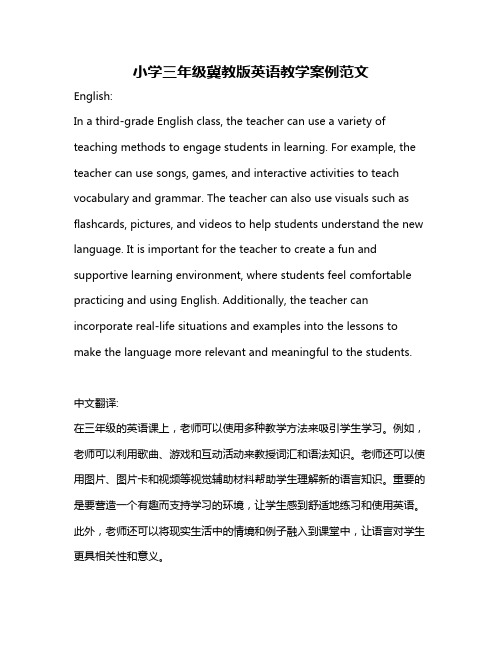
小学三年级冀教版英语教学案例范文English:In a third-grade English class, the teacher can use a variety of teaching methods to engage students in learning. For example, the teacher can use songs, games, and interactive activities to teach vocabulary and grammar. The teacher can also use visuals such as flashcards, pictures, and videos to help students understand the new language. It is important for the teacher to create a fun and supportive learning environment, where students feel comfortable practicing and using English. Additionally, the teacher can incorporate real-life situations and examples into the lessons to make the language more relevant and meaningful to the students.中文翻译:在三年级的英语课上,老师可以使用多种教学方法来吸引学生学习。
例如,老师可以利用歌曲、游戏和互动活动来教授词汇和语法知识。
老师还可以使用图片、图片卡和视频等视觉辅助材料帮助学生理解新的语言知识。
重要的是要营造一个有趣而支持学习的环境,让学生感到舒适地练习和使用英语。
此外,老师还可以将现实生活中的情境和例子融入到课堂中,让语言对学生更具相关性和意义。
初中英语“以读促写”教学案例——以牛津版英语七年级下册Unit_4_的Readig板块为例
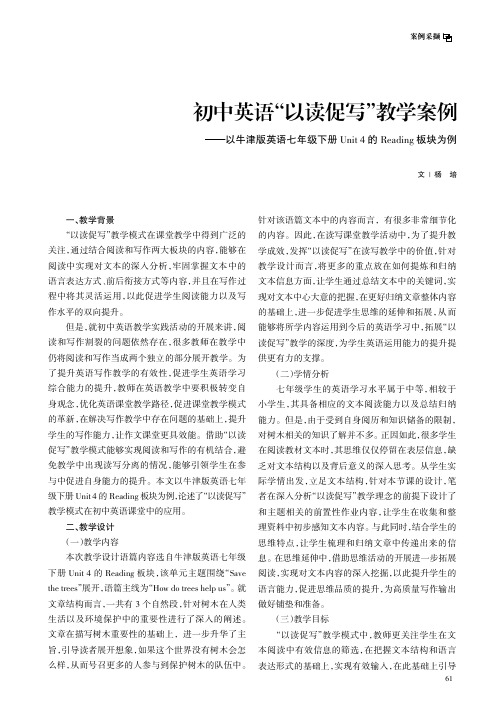
案例采撷初中英语“以读促写”教学案例———以牛津版英语七年级下册Unit4的Reading板块为例文|杨培一、教学背景“以读促写”教学模式在课堂教学中得到广泛的关注,通过结合阅读和写作两大板块的内容,能够在阅读中实现对文本的深入分析,牢固掌握文本中的语言表达方式、前后衔接方式等内容,并且在写作过程中将其灵活运用,以此促进学生阅读能力以及写作水平的双向提升。
但是,就初中英语教学实践活动的开展来讲,阅读和写作割裂的问题依然存在,很多教师在教学中仍将阅读和写作当成两个独立的部分展开教学。
为了提升英语写作教学的有效性,促进学生英语学习综合能力的提升,教师在英语教学中要积极转变自身观念,优化英语课堂教学路径,促进课堂教学模式的革新,在解决写作教学中存在问题的基础上,提升学生的写作能力,让作文课堂更具效能。
借助“以读促写”教学模式能够实现阅读和写作的有机结合,避免教学中出现读写分离的情况,能够引领学生在参与中促进自身能力的提升。
本文以牛津版英语七年级下册Unit4的Reading板块为例,论述了“以读促写”教学模式在初中英语课堂中的应用。
二、教学设计(一)教学内容本次教学设计语篇内容选自牛津版英语七年级下册Unit4的Reading板块,该单元主题围绕“Save the trees”展开,语篇主线为“How do trees help us”。
就文章结构而言,一共有3个自然段,针对树木在人类生活以及环境保护中的重要性进行了深入的阐述。
文章在描写树木重要性的基础上,进一步升华了主旨,引导读者展开想象,如果这个世界没有树木会怎么样,从而号召更多的人参与到保护树木的队伍中。
针对该语篇文本中的内容而言,有很多非常细节化的内容。
因此,在读写课堂教学活动中,为了提升教学成效,发挥“以读促写”在读写教学中的价值,针对教学设计而言,将更多的重点放在如何提炼和归纳文本信息方面,让学生通过总结文本中的关键词,实现对文本中心大意的把握,在更好归纳文章整体内容的基础上,进一步促进学生思维的延伸和拓展,从而能够将所学内容运用到今后的英语学习中,拓展“以读促写”教学的深度,为学生英语运用能力的提升提供更有力的支撑。
英语教学案例范文 (2)
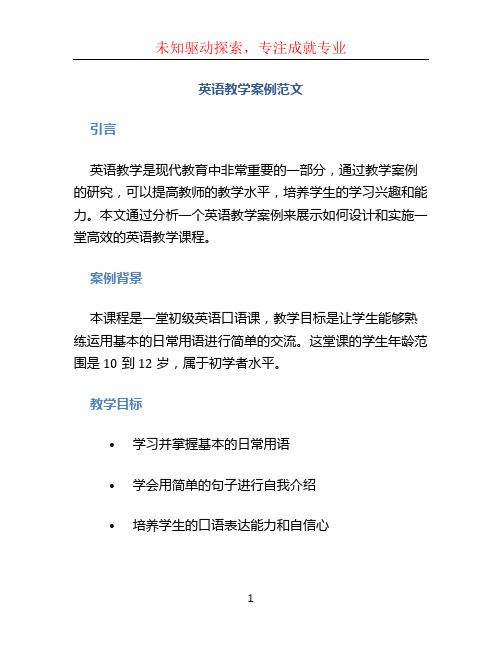
英语教学案例范文引言英语教学是现代教育中非常重要的一部分,通过教学案例的研究,可以提高教师的教学水平,培养学生的学习兴趣和能力。
本文通过分析一个英语教学案例来展示如何设计和实施一堂高效的英语教学课程。
案例背景本课程是一堂初级英语口语课,教学目标是让学生能够熟练运用基本的日常用语进行简单的交流。
这堂课的学生年龄范围是10到12岁,属于初学者水平。
教学目标•学习并掌握基本的日常用语•学会用简单的句子进行自我介绍•培养学生的口语表达能力和自信心教学过程导入(5分钟)在课程开始的时候,教师可以通过播放一段英语儿童歌曲来吸引学生的注意力。
然后,教师可以使用图片或手势引导学生学习一些日常用语的发音和词汇,比如问候语和简单的自我介绍。
呈现(15分钟)在呈现部分,教师可以使用多媒体工具展示一些与本节课内容相关的图片和短句子,然后请学生跟随教师一起朗读和模仿。
教师可以通过示范和反复练习来帮助学生掌握正确的发音和语调。
实践(30分钟)实践阶段是本节课的重点,教师可以设计一系列的口语练习活动,让学生有机会运用所学的语言进行交流。
以下是一些实践活动的示例:1.对话练习:教师可以提供一些情景和对话模板,让学生分角色进行练习,比如购物、问路、订餐等。
2.小组讨论:教师可以将学生分成小组,让他们就一个特定的话题进行讨论,并在每个小组之间进行分享和展示。
3.角色扮演:教师可以给学生分发一些角色卡片,让他们扮演不同的角色进行对话练习,比如在餐厅点餐或者在学校自我介绍。
总结(10分钟)在本节课的总结部分,教师可以通过小组讨论和学生个别表演等形式来检查学生的掌握情况。
同时,教师可以提供一份简单的练习册或作业来巩固学生的学习成果。
教学评价方法为了评价学生的学习成果和教学效果,教师可以采用以下方法:1.听力和口语测试:通过听学生进行口头回答问题或进行角色扮演活动来评价他们的听力和口语能力。
2.作业评价:评价学生完成的练习册、作业和小组讨论的表现。
完整)小学英语写作课教学案例
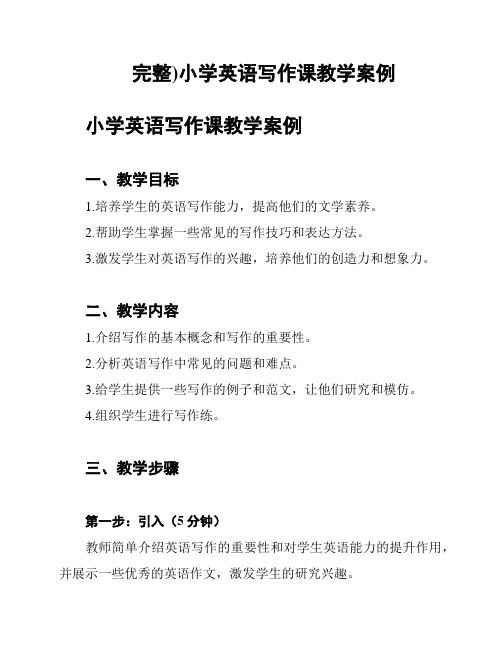
完整)小学英语写作课教学案例小学英语写作课教学案例一、教学目标1.培养学生的英语写作能力,提高他们的文学素养。
2.帮助学生掌握一些常见的写作技巧和表达方法。
3.激发学生对英语写作的兴趣,培养他们的创造力和想象力。
二、教学内容1.介绍写作的基本概念和写作的重要性。
2.分析英语写作中常见的问题和难点。
3.给学生提供一些写作的例子和范文,让他们研究和模仿。
4.组织学生进行写作练。
三、教学步骤第一步:引入(5分钟)教师简单介绍英语写作的重要性和对学生英语能力的提升作用,并展示一些优秀的英语作文,激发学生的研究兴趣。
第二步:讲解写作技巧(15分钟)教师用简单易懂的语言向学生介绍英语写作中常见的问题和难点,并给出相应的解决方法和技巧,如使用形象的语言,运用适当的连词等。
第三步:示范写作(10分钟)教师向学生展示一篇优秀的英语作文,并解读其中的写作技巧和表达方法。
帮助学生理解并吸收这些技巧和方法。
第四步:练写作(25分钟)学生按照教师的指导,选择一个话题进行写作练。
教师可以给予一些写作的框架和提示,引导学生进行思考和表达。
第五步:检查与评价(5分钟)学生完成写作后,教师对学生的作品进行检查和评价。
鼓励学生互相分享,并提供一些建设性的意见和建议。
四、教学资源1.优秀的英语作文范文。
2.丰富的写作例子和题目供学生选择和参考。
3.适当的写作指导和技巧介绍。
五、课堂互动方式1.讨论和辩论:学生可以在小组或全班中共同讨论和解决写作问题。
2.合作写作:学生可以在小组中互相激励和帮助,合作完成一个作文。
3.写作展示:学生可以在班级中展示自己的作品,获得其他同学的认可和鼓励。
六、教学效果评估1.学生的主动参与程度。
2.学生的写作作品质量和改进程度。
3.学生在课堂上的表现和讨论。
七、教学反馈与调整根据学生在课堂上的表现和评估结果,及时调整教学内容和方法,提供更好的研究体验和效果。
以上就是小学英语写作课教学案例,希望能够对教学实践有所帮助。
教资英语作文课教案初中

教资英语作文课教案初中教学目标:1. 让学生能够运用英语描述自己的爱好。
2. 提高学生的英语写作能力和表达能力。
3. 培养学生的英语思维和创造力。
教学内容:1. 单词:hobby, interest, like, enjoy, collect, read, write, draw, listen to music, play sports2. 句型:What is your hobby? I like doing sth. I enjoy watching/reading/listening to sth.3. 语法:一般现在时教学步骤:Step 1: 导入(5分钟)1. 教师与学生进行简单的英语对话,询问学生的周末活动。
2. 引导学生谈论自己的爱好,并板书相关单词和句型。
Step 2: 讲解(15分钟)1. 教师讲解一般现在时的用法。
2. 教师通过示例,讲解如何用一般现在时描述自己的爱好。
Step 3: 练习(15分钟)1. 学生分组,每组选择一个爱好,用英语进行描述。
2. 学生互相练习,教师巡回指导。
Step 4: 写作(15分钟)1. 教师给出写作题目:"My Hobbies"。
2. 学生根据自己的爱好,用英语写一篇短文。
Step 5: 展示和评价(10分钟)1. 学生展示自己的作文,其他学生进行评价。
2. 教师对学生的作文进行点评,给出改进意见。
Step 6: 总结(5分钟)1. 教师总结本节课的学习内容。
2. 学生进行自我评价,教师给予鼓励。
教学评价:1. 学生能够运用英语描述自己的爱好。
2. 学生的英语写作能力和表达能力得到提高。
3. 学生能够正确使用一般现在时描述自己的爱好。
教学反思:在课后,教师应认真反思本节课的教学效果,针对学生的掌握情况,调整教学策略,以提高学生的英语水平。
同时,教师应注重培养学生的英语思维和创造力,激发学生学习英语的兴趣。
教学案例反思英语作文
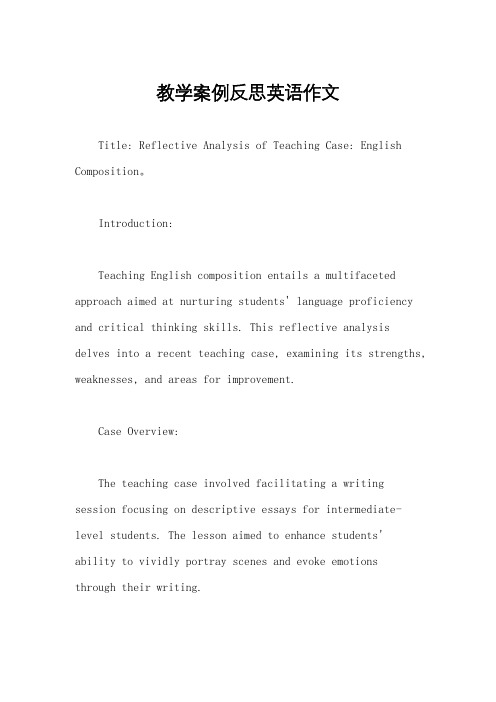
教学案例反思英语作文Title: Reflective Analysis of Teaching Case: English Composition。
Introduction:Teaching English composition entails a multifaceted approach aimed at nurturing students' language proficiency and critical thinking skills. This reflective analysis delves into a recent teaching case, examining its strengths, weaknesses, and areas for improvement.Case Overview:The teaching case involved facilitating a writing session focusing on descriptive essays for intermediate-level students. The lesson aimed to enhance students'ability to vividly portray scenes and evoke emotionsthrough their writing.Reflections:1. Engagement Strategies:Implementing diverse engagement strategies proved effective in capturing students' interest and fostering active participation. Activities such as brainstorming sessions, peer discussions, and multimedia presentations kept learners engaged and motivated throughout the lesson.2. Clear Learning Objectives:Establishing clear learning objectives at the outset of the lesson facilitated a focused and structured learning experience. By outlining specific goals, such as improving descriptive language usage and narrative techniques, students had a clear understanding of what was expected of them.3. Scaffolded Instruction:Scaffolded instruction, encompassing gradual release ofresponsibility and differentiated support, played a crucial role in accommodating diverse learning needs. Providing model essays, scaffolding graphic organizers, and offering personalized feedback enabled students to scaffold their writing skills effectively.4. Formative Assessment:Integrating formative assessment strategies, such as peer review sessions and self-assessment checklists, facilitated ongoing feedback and reflection. These assessment tools empowered students to critically evaluate their own writing and provided valuable insights for improvement.5. Integration of Technology:The integration of technology, including online writing platforms and multimedia resources, enriched the learning experience and catered to digital-native learners' preferences. Leveraging technology enhanced accessibility, collaboration, and creativity in the writing process.Areas for Improvement:1. Differentiation:While efforts were made to accommodate diverse learning needs, further differentiation strategies could be explored to provide targeted support for struggling learners and challenge advanced students appropriately.2. Authentic Contexts:Incorporating more authentic contexts and real-world writing tasks could enhance students' motivation and relevance of their learning experiences. Connecting writing tasks to personal experiences, current events, or interdisciplinary topics can foster deeper engagement and application of language skills.3. Metacognitive Strategies:Explicitly teaching metacognitive strategies, such asgoal setting, planning, and self-regulation, could empower students to become more autonomous and reflective writers. Encouraging students to reflect on their writing processes and identify areas for improvement can foster greater self-awareness and growth.Conclusion:Reflecting on the teaching case underscores the importance of dynamic instructional approaches, clear learning objectives, and ongoing assessment practices in fostering students' English composition skills. By capitalizing on strengths and addressing areas for improvement, educators can cultivate a supportive learning environment conducive to students' language development and academic growth.。
小组合作教学案例英语作文
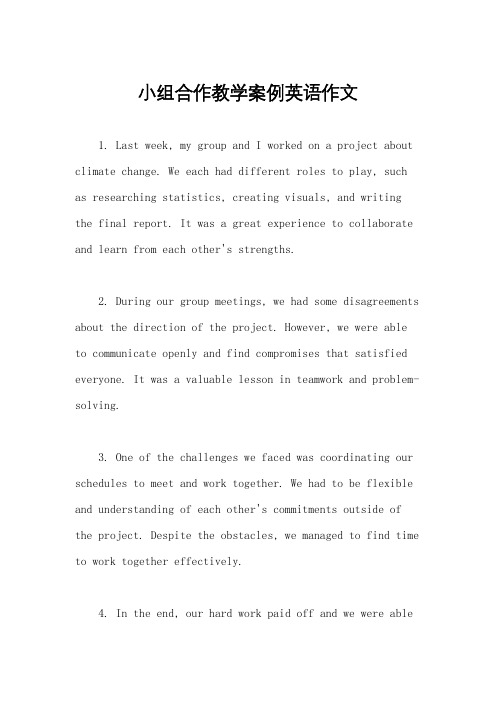
小组合作教学案例英语作文1. Last week, my group and I worked on a project about climate change. We each had different roles to play, such as researching statistics, creating visuals, and writing the final report. It was a great experience to collaborate and learn from each other's strengths.2. During our group meetings, we had some disagreements about the direction of the project. However, we were able to communicate openly and find compromises that satisfied everyone. It was a valuable lesson in teamwork and problem-solving.3. One of the challenges we faced was coordinating our schedules to meet and work together. We had to be flexible and understanding of each other's commitments outside of the project. Despite the obstacles, we managed to find time to work together effectively.4. In the end, our hard work paid off and we were ableto present our project to the class. It was rewarding to see how our individual contributions came together to create a cohesive and informative presentation. I felt proud of what we accomplished as a team.5. Working in a group taught me the importance of communication, compromise, and collaboration. I gained valuable skills that will benefit me in future projects and endeavors. I am grateful for the opportunity to work with such a dedicated and talented group of classmates.。
英语作文优秀教学案例范文

英语作文优秀教学案例范文英文回答:Teaching English as a foreign language can be adaunting task, especially when it comes to teaching writing. However, with the right approach and a little bit of creativity, you can help your students improve theirwriting skills significantly.One of the most important things to keep in mind when teaching writing is that it is a process. It takes time and practice for students to develop their writing skills. Be patient with your students and provide them with plenty of opportunities to practice.Another important thing to keep in mind is that writing is a skill that can be learned. There are a number of techniques and strategies that you can teach your studentsto help them improve their writing. For example, you can teach them how to brainstorm ideas, organize their thoughts,and use effective grammar and vocabulary.In addition to teaching your students the basics of writing, it is also important to provide them with opportunities to write for different purposes and audiences. This will help them learn how to adapt their writing styleto different situations.For example, you could have your students write essays, stories, poems, or even songs. You could also have themwrite letters to friends or family members, or articles for a school newspaper.The more your students write, the better they will become at it. So, provide them with plenty of opportunities to practice and give them feedback on their work. With time and effort, your students will be able to write with confidence and clarity.中文回答:作为一门外语,英语写作教学是一项艰巨的任务,尤其是在教授写作方面。
人教版英语教育教学优秀案例范文
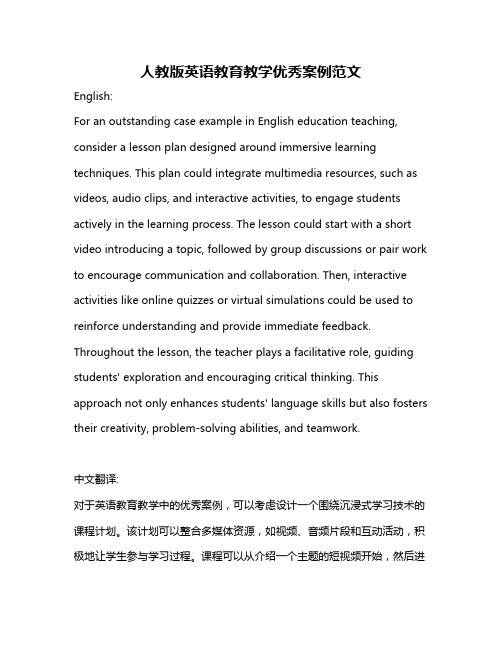
人教版英语教育教学优秀案例范文English:For an outstanding case example in English education teaching, consider a lesson plan designed around immersive learning techniques. This plan could integrate multimedia resources, such as videos, audio clips, and interactive activities, to engage students actively in the learning process. The lesson could start with a short video introducing a topic, followed by group discussions or pair work to encourage communication and collaboration. Then, interactive activities like online quizzes or virtual simulations could be used to reinforce understanding and provide immediate feedback. Throughout the lesson, the teacher plays a facilitative role, guiding students' exploration and encouraging critical thinking. This approach not only enhances students' language skills but also fosters their creativity, problem-solving abilities, and teamwork.中文翻译:对于英语教育教学中的优秀案例,可以考虑设计一个围绕沉浸式学习技术的课程计划。
教学亮点案例英语作文
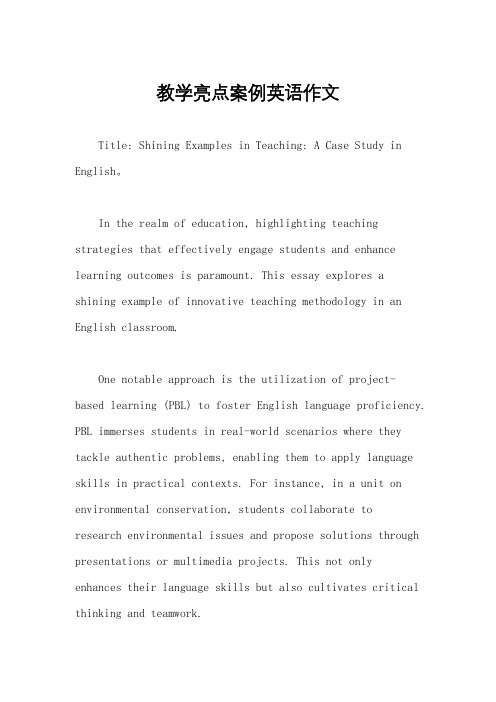
教学亮点案例英语作文Title: Shining Examples in Teaching: A Case Study in English。
In the realm of education, highlighting teaching strategies that effectively engage students and enhance learning outcomes is paramount. This essay explores ashining example of innovative teaching methodology in an English classroom.One notable approach is the utilization of project-based learning (PBL) to foster English language proficiency. PBL immerses students in real-world scenarios where they tackle authentic problems, enabling them to apply language skills in practical contexts. For instance, in a unit on environmental conservation, students collaborate toresearch environmental issues and propose solutions through presentations or multimedia projects. This not only enhances their language skills but also cultivates critical thinking and teamwork.Another compelling technique is incorporating technology as a tool for language acquisition. Integrating digital platforms such as educational apps, interactive whiteboards, and online forums provides diverse learning opportunities. For instance, using language learning apps allows students to practice vocabulary and grammar independently, tailored to their proficiency levels. Additionally, online forums facilitate peer collaboration and cultural exchange, broadening students' perspectives on language usage and cultural nuances.Furthermore, differentiated instruction caters to diverse learner needs within the classroom. By offering varied instructional approaches, teachers accommodate different learning styles, abilities, and interests. For example, in a literature unit, students may have the option to choose from a range of novels or texts based on their preferences and reading levels. Additionally, providing scaffolded support ensures that all students can access the curriculum regardless of their proficiency level, thereby promoting inclusivity and equity in learning.Moreover, fostering a communicative and supportive classroom environment is essential for language acquisition. Encouraging authentic communication through discussions, debates, and role-plays cultivates students' speaking and listening skills while promoting confidence in language use. Establishing a safe space where students feel comfortable expressing themselves without fear of judgment is crucialfor language development. For instance, implementing peer feedback sessions encourages constructive criticism andpeer learning, empowering students to take ownership oftheir learning process.In conclusion, incorporating innovative teaching methodologies such as project-based learning, technology integration, differentiated instruction, and fostering a communicative classroom environment can significantly enhance English language acquisition. By creating engaging and inclusive learning experiences, educators empower students to become proficient communicators and critical thinkers. These shining examples in teaching pave the wayfor transformative educational practices that inspire lifelong learning and academic success.。
作用思维导图进行英语作文教学案例作文

作用思维导图进行英语作文教学案例作文全文共3篇示例,供读者参考篇1Mind Maps and English Writing: A Fun Way to Express My Ideas!Hi there! My name is Lily and I'm a 5th grader at Oakwood Elementary School. Today I want to tell you all about how my teacher, Mr. Roberts, has been using these really cool things called "mind maps" to help us with our English writing assignments. Mind maps are like idea maps that use pictures, symbols, and colors to help us organize our thoughts before we start writing. They have been super helpful and made writing a lot more fun!When we first started using mind maps a few months ago, I wasn't sure what to think. Mr. Roberts put a big blank piece of paper on the board and drew a circle in the middle. He said that circle would be the main topic or subject we were going to write about. Then he had us call out words and ideas related to that topic, and he drew branches coming off the main circle withthose words written on them. The more ideas we gave him, the more branches got added!At first, it felt kind of messy and all over the place. But as we kept going, I started to see how all the ideas were connecting to the main topic like a big web. Mr. Roberts used different colors for different categories of ideas too, which really helped make it pop off the page. By the end, the mind map looked like a crazy, colorful tree with the trunk as the main topic and all these branches for different thoughts and details spreading out. It was awesome!Using mind maps has helped me in so many ways when it comes to English writing assignments. One of the biggest problems I used to have was just getting my ideas organized before starting the actual writing part. My first drafts always felt like a jumbled mess because my thoughts were everywhere! With mind maps, I can get everything out of my brain and onto the page in a visual way first. I can move ideas around, group related thoughts together, and really start to see how all the pieces can fit as part of a bigger picture.Another super helpful thing about mind maps is how they spark my creativity. Sometimes when I'm staring at a blank paper or computer screen, it's really hard for me to get inspired andcome up with ideas to write about. But mapping out my thoughts in a more free-flowing, visual way gets my creative juices flowing. Seeing ideas branch off into new directions makes me think of connections I may not have otherwise. Using different colors, shapes, and little doodles also keeps things fun and engaging.I especially love using mind maps when we're working on fictional writing assignments like short stories or narratives. Instead of just listing out characters, setting details, and plot events in a boring outline, mind mapping lets me really visualize the narrative and how everything interacts. For my last creative writing piece, the middle circle was the main character. Then I did branches for her personality traits, her goals and motivations, the obstacles she'd face, and other key characters. From there, I could map out the setting where the story would take place and web out to explore different plotlines and potential endings. By the time I started my draft, I had such a clear picture in my mind of the whole narrative just from referencing my mind map!Of course, mind maps aren't just great for fictional writing - they can help with any kind of writing project. If we're working on a research paper or essay, we can mind map out the main thesis or topic first, then branch out into all the key points,evidence, examples, and sourcing we want to include. Having it all laid out visually makes it so much easier to organize and put into a logical sequence for the actual paper!Mr. Roberts often has us do mind maps as a class all together first, but then we practice making individual ones too. Sometimes we'll do ones on the classroom whiteboard, other times we use big chart papers or even computer software to create digital mind maps we can edit and update easily. No matter what format we use though, the core process is the same - start with your main idea in the center, then just freely map out all your connected thoughts branching off from there using words, symbols, colors, and anything else that helps you visualize the concepts better.I used to absolutely dread writing assignments because staring at a blank page made my mind go blank too. But mind mapping has changed everything for me! It makes writing feel more like a fun creative exploration rather than some chore I'm struggling through. I can get all my raw ideas out in whatever random order they come to me, then organize them in a way that flows and makes sense. Mr. Roberts always reminds us that mind maps aren't meant to be perfect works of art either - they can be messy and weird because that's how our brains naturallywork. Getting those thoughts down in a visual way first takes so much stress and anxiety out of the writing process.So if you're a student who gets frustrated or blocked when it comes to writing, I'd highly recommend giving mind mapping a try! It might look a little silly and overwhelming at first, but stick with it. The more you practice mapping out your ideas this way, the better you'll get at organizing your thoughts and making connections you may have missed before. Writing doesn't have to be this painful, scary thing - mind maps help make it way more enjoyable and easier to express all the awesome ideas bouncing around in your creative mind. Get those colored pencils ready and start mapping!篇2Using Mind Maps to Help with English WritingMy name is Lily and I'm in 5th grade. Learning to write well in English can be really hard sometimes. There are so many rules to remember about grammar, spelling, and how to organize your ideas into paragraphs and essays. It can feel overwhelming! That's why I was really excited when my teacher Mrs. Johnson introduced us to using mind maps for our English writingassignments. Mind maps have helped me a lot and I think they can help other kids too.What is a Mind Map?A mind map is a diagram that shows thoughts, ideas, and facts branching off from a central topic. It uses lines, colors, symbols, words, and pictures to help you visualize connections between ideas. The main topic goes in the middle and then you draw branches for subtopics and details related to the main topic.Mind maps are really flexible - you can make them as simple or as complex as you need. And they don't have to be perfect artistic masterpieces! The most important thing is getting all your thoughts and information organized in a way that makes sense to you.How Mind Maps Help with WritingUsing mind maps has helped me with my English writing in so many ways:Brainstorming IdeasBefore I learned about mind maps, I would just stare at a blank page trying to think of what to write about for an assignment. My mind would go blank or I would have a jumbleof random disconnected thoughts. With mind mapping, I can start with my main topic in the center and just freely jot down any related ideas that pop into my head as branches. I don't have to organized or censor my thoughts, I can get everything down in a way that shows how the ideas are connected. This makes the brainstorming process much easier and more productive.Organizing ThoughtsOnce I have all my ideas branch mapped, I can easily Start to group related thoughts into potential paragraphs and sections. The visual layout of the mind map makes it obvious which ideas should be chunked together. I can even played numbers next to the branches to show what order I want to discuss things in. This helps me organize my wholeessays outline before I ever start writing the draft.Remembering DetailsWhen I just try to memorize facts, dates, vocabulary, quotes, and other details, a lot of times I'll blank on them when I go to write. But when I integrate those details into my mind maps, associating them with the main topic and subtopics, it becomes much easier for me to remember them and work them into my writing naturally and logically. The visual Connections in the mind map help cement the information in my brain.Seeing the Big PictureSometimes when I'm writing an essay, I'll get really focused in on one particular paragraph or idea and kind oflose sight of how it fits into the overall paper. With a mind map, I can continually glance back at my complete overview of the topic to keep my perspective on the main concepts and how all the details fit together coherently. The mind map is like my guide to the destination.Making Writing More FunLet's be honest, writing essays can be kind of tedious and boring. But mind mapping makes it more interactive, creative, and vibrant. I can doodle related pictures, use different colors for various branches, Make certain ideas bigger or smaller, and really make my mind map look engaging and appealing. This injects some much-needed fun and liveliness into the whole writing process for me. When writing becomes more enjoyable, I'm able to stay motivated and focused much better.Different Styles for Different NeedsThere are also different styles and techniques you can use for mind mapping based on the particular writing task. For example, if I'm doing a narrative essay telling a personal story, Imight make a timeline-style mind map that maps out the key events and details in chronological order as my outline. But if I'm writing a persuasive essay arguing a point, I might make my mind map more concentrated on the main claims, supporting evidence, counterarguments, and rebuttals I want to cover.I can honestly say that learning how to utilize mind maps for my English writing assignments has been a total game-changer for me. They've helped make the writing process so much easier, from starting with a messy unorganized brainstorm to ending up with a polished, well-structured final draft. And most importantly, they've made writing much more enjoyable and creatively stimulating rather than rote and monotonous. Highly recommend giving mind mapping a try for all you student writers out there!篇3Using Mind Maps to Write Better English EssaysHi there! My name is Sarah and I'm a 5th grader. Today I want to tell you about this really cool thing called mind mapping that has helped me become a much better writer in English class.Before we started using mind maps, writing essays used to be so hard for me. My teacher would give us a topic like "MyFavorite Memory" or "If I Could Have Any Superpower" and I would just stare at the blank page feeling totally stuck. Where do I even start? What should my intro paragraph be about? How many body paragraphs should I have and what points do I include in each one? It was all so confusing and overwhelming.But then Mrs. Thompson taught us about mind mapping and everything changed! A mind map is kind of like making a tree branches out from the trunk - you start with your main topic in the middle, then add branches coming off of that for your main ideas, and then put details or examples on each of those branches.Let me give you an example of what one of my mind maps looks like. Let's say the essay prompt is "What is your favorite season and why?" Here's how I would set up my mind map:In the center circle I would write: "My Favorite Season: Summer"Then, coming off that center circle in different directions, I'll add branches for my three main reasons why I love summer so much:Fun outdoor activitiesNo school/homeworkWarm weatherFrom each of those branches, I'll add even smaller branches with details and examples for each main point. So for the "Fun outdoor activities" branch, some subbranches could be:SwimmingHaving picnicsGoing to the beachRiding bikePlaying sports like baseballFor the "No school" branch, I may add details like:Can sleep in lateDon't have any testsCan travel with familyAnd for "Warm weather", maybe:Wear shorts/t-shirtsCan go to water parksWeather is sunny and beautifulUsing a mind map quite literally maps out ALL my thoughts in a super visual way before I even start writing the actual essay. It helps me organize ALL my ideas from the very beginning in a way that makes sense, instead of feeling lost and trying to do it all at once as I'm writing.With all the thoughts and details already mapped out, writing the essay itself becomes SO much easier. I basically just start with my intro paragraph introducing the topic of my favorite season being summer. Then I have a body paragraph about fun outdoor activities, using all the details from that branch as my supporting examples. Another body paragraph is about no school/homework, another about warm weather, etc.And just like that, using a mind map as a prewriting strategy has given me a solid plan and outline for my entire essay BEFORE even getting started on writing the drafts. No more staring at a blank screen without a clue of where to start!Mind mapping has honestly revolutionized how I approach the entire writing process. It works for any kind of essay too - persuasive essays, research papers, literary analysis, you name it. The mind map keeps me focused and prevents me from going off on random tangents in my writing. If an idea doesn't fit intoone of the branches on the mind map, then it doesn't belong in that particular essay.Not only that, but working through the mind map step gets my creative juices flowing. Looking at the branches sparks me to come up with better examples, more specific details, unique ideas that I may not have initially thought of if I just started writing freely. The map makes me really explore and exhaust all aspects of the topic at hand.Another awesome benefit is that mind mapping has helped me become a stronger researcher too. When I have to write an essay that requires outside facts and evidence, I start by mind mapping just with the main topic or thesis in the center. Then as I'm doing my research, I add branches for key points I want to make, and put the information I find onto those branches along with where I found it. That way I'm actively organizing my notes as I research instead of just collecting a random pile of information.Mind mapping has given me this incredibly useful tool to lean on for literally every step of the writing process. It helps me explore and organize my thoughts upfront, guides me in incorporating examples and details, assists me in research, and essentially creates an outline to follow in my drafts. No morejumping around between different points or losing my train of thought halfway through.I really struggle with feeling overwhelmed when it comes to big writing assignments. But using mind maps has given me this reliable method to break things down in a way that makes the enormous task of essay writing feel manageable. Instead of feeling lost, I feel in control and confident that I can tackle any writing prompt that comes my way.Honestly, I truly don't know how I ever wrote essays before without mind mapping! This strategy has helped me improve my writing skills so much. My essays have become clearer, more focused, better organized and flow in a logical way from start to finish. Thanks to mind maps, I'm finally able to take all the jumbled thoughts in my brain and turn them into polished, well-supported pieces of writing that I'm really proud of.Not only that, but mind mapping has been so helpful for me in other subjects too. I've started using it to organize my thoughts for science projects, book reports, oral presentations, you name it. Anytime I need to organize a lot of different ideas, mind mapping is now my go-to strategy to get it all down in a visual way that makes sense to me.So if you're a student who struggles with writing essays or just getting your thoughts in order, I cannot recommend mind mapping enough! It's such a simple, easy technique that has been an absolute game-changer for me. Give it a try and I'm confident you'll see your writing skills improve in no time, just like I did.。
英语作文写作教学设计
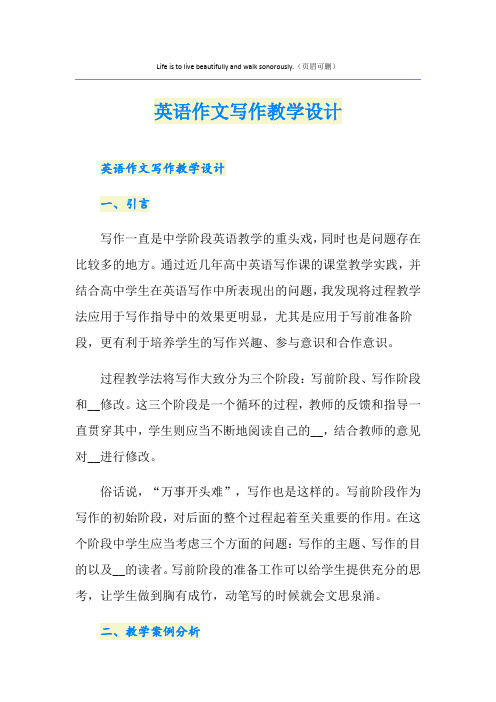
Life is to live beautifully and walk sonorously.(页眉可删)英语作文写作教学设计英语作文写作教学设计一、引言写作一直是中学阶段英语教学的重头戏,同时也是问题存在比较多的地方。
通过近几年高中英语写作课的课堂教学实践,并结合高中学生在英语写作中所表现出的问题,我发现将过程教学法应用于写作指导中的效果更明显,尤其是应用于写前准备阶段,更有利于培养学生的写作兴趣、参与意识和合作意识。
过程教学法将写作大致分为三个阶段:写前阶段、写作阶段和__修改。
这三个阶段是一个循环的过程,教师的反馈和指导一直贯穿其中,学生则应当不断地阅读自己的__,结合教师的意见对__进行修改。
俗话说,“万事开头难”,写作也是这样的。
写前阶段作为写作的初始阶段,对后面的整个过程起着至关重要的作用。
在这个阶段中学生应当考虑三个方面的问题:写作的主题、写作的目的以及__的读者。
写前阶段的准备工作可以给学生提供充分的思考,让学生做到胸有成竹,动笔写的时候就会文思泉涌。
二、教学案例分析下面这个教学案例是实践中的一部分,这个案例中写前阶段的信息输入是选取了brainstorming这种形式。
(一)写作话题的选取为了更好的贴近学生的生活,我选取了一个与学生息息相关的一个话题:Living in Big Cities(居住在大城市)。
上海是一个国际型大都市,学生们就生活在这样一个氛围中,对这个话题很熟悉。
这堂课主要采取的是小组讨论发言的形式,将全班同学每四人分为一个小组,让每个小组先内部讨论然后再发言。
(二)引导性问题的提出开始的时候同学们并不太活跃,思路并没有打开。
笔者考虑到可能有些学生的思维不够开阔,于是就在请学生发言之前提出了一些引导性的问题:Do you like living in Shanghai?Have you ever been living in small cities or countryside?Can you give me your reasons why you like or why you don’t like living in Shanghai?Which part of Shanghai do you like best?Do you think it is easy to live in big cities?When you grow up, where do you want to live, if possible?(三)Brainstorming我每提出一个问题会给大家几秒钟的时间思考,这些问题果然起到了抛砖引玉的作用,学生们开始变得活跃起来。
英语作文教学案例
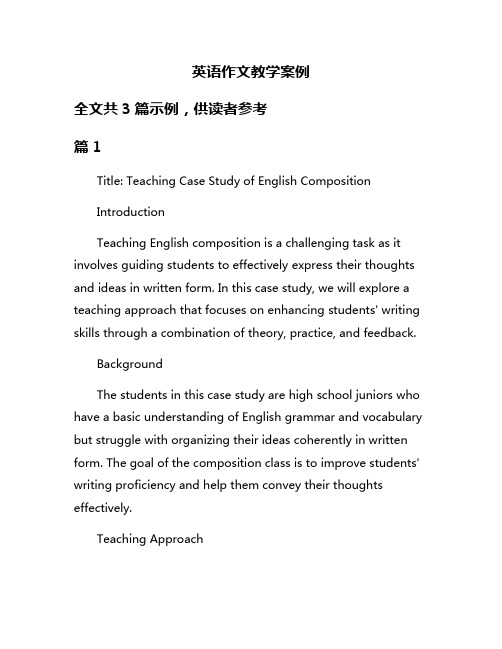
英语作文教学案例全文共3篇示例,供读者参考篇1Title: Teaching Case Study of English CompositionIntroductionTeaching English composition is a challenging task as it involves guiding students to effectively express their thoughts and ideas in written form. In this case study, we will explore a teaching approach that focuses on enhancing students' writing skills through a combination of theory, practice, and feedback.BackgroundThe students in this case study are high school juniors who have a basic understanding of English grammar and vocabulary but struggle with organizing their ideas coherently in written form. The goal of the composition class is to improve students' writing proficiency and help them convey their thoughts effectively.Teaching ApproachThe teacher adopts a three-step approach to teaching English composition: theory, practice, and feedback. In the theory stage, the teacher introduces fundamental principles of composition such as thesis statements, topic sentences, supporting arguments, and conclusion. Students are encouraged to analyze sample essays and identify key components of effective writing.In the practice stage, students are given writing prompts that require them to apply the theory they have learned. For example, students may be asked to write a persuasive essay on a given topic or analyze a literary text. The teacher provides guidance on brainstorming, outlining, and drafting to help students structure their ideas logically.In the feedback stage, students submit their drafts for peer review and receive constructive criticism from their classmates. The teacher also provides individual feedback on each student's writing, highlighting strengths and areas for improvement. This feedback loop enables students to refine their writing skills and gradually develop their own unique writing style.Case StudyOne of the students in the class, Sarah, initially struggled with organizing her ideas in written form. Despite having strongvocabulary and grammar skills, Sarah's essays lacked coherence and failed to convey a clear argument. Through the three-step approach to teaching composition, Sarah gradually improved her writing skills.In the theory stage, Sarah learned about the importance of a strong thesis statement and supporting arguments. She analyzed sample essays and identified how successful writers structured their arguments effectively. In the practice stage, Sarah applied these principles to her own writing by outlining her ideas and focusing on developing a clear argument. With guidance from the teacher, Sarah learned to revise her drafts multiple times to refine her arguments and clarify her ideas.In the feedback stage, Sarah received constructive criticism from her peers and teacher. She learned to accept feedback gracefully and use it to improve her writing. By listening to different perspectives and incorporating suggestions from her classmates, Sarah was able to refine her writing style and convey her ideas more effectively.OutcomeBy the end of the composition class, Sarah had made significant progress in her writing skills. Her essays became more coherent, well-structured, and persuasive. Sarah's ability toconvey her ideas effectively improved, and she developed a stronger sense of confidence in her writing.ConclusionTeaching English composition requires a combination of theory, practice, and feedback. By providing students with a solid foundation in composition principles, opportunities to practice writing, and constructive feedback, teachers can help students improve their writing skills and become more effective communicators. Through this case study, we have seen how a structured approach to teaching composition can help students like Sarah develop their writing proficiency and express their ideas with clarity and coherence.篇2Title: Teaching Case Study on English CompositionIntroduction:English composition is an essential skill for students to master as it not only improves their language proficiency but also hones their critical thinking and creativity. In this teaching case study, I will share my approach to teaching English composition to a group of middle school students, focusing on developing their writing skills and fostering a love for writing.Background Information:The students in this case study are a diverse group of middle school students with varying levels of proficiency in English. Some students are native English speakers, while others are English language learners. The goal of the teaching approach is to cater to the individual needs of each student and provide a supportive environment for them to grow as writers.Teaching Strategies:1. Building a Foundation:To begin, I focus on building a solid foundation in English composition by introducing the basic elements of writing such as grammar, punctuation, and sentence structure. I provide students with ample practice exercises and feedback to help them refine their writing skills.2. Promoting Creativity:In addition to mastering the technical aspects of writing, I also emphasize the importance of creativity in composition. I encourage students to explore different writing styles, genres, and topics to spark their imagination and unleash their creativity.3. Peer Collaboration:To foster a sense of community and collaboration among students, I incorporate peer editing and group writing activities into the curriculum. This helps students learn from each other, provide constructive feedback, and improve their writing skills through interaction with their peers.4. Individualized Feedback:I believe that personalized feedback is crucial in helping students grow as writers. I provide detailed feedback on each student's writing, highlighting their strengths and areas for improvement. I also encourage students to set goals for their writing and track their progress over time.5. Integration of Technology:I leverage technology to enhance the teaching of English composition by incorporating online writing tools, multimedia resources, and digital platforms for publishing students' work. This not only makes the learning experience more engaging and interactive but also prepares students for the digital age.Outcome:By the end of the teaching period, the students have shown significant improvement in their writing skills and confidence. They have developed a deeper appreciation for writing and areable to express their thoughts and ideas more effectively. Some students have even discovered a passion for writing and continue to explore their creative potential beyond the classroom.Conclusion:Teaching English composition is a rewarding experience that requires patience, creativity, and dedication. By adopting a holistic approach that focuses on building a strong foundation, promoting creativity, fostering peer collaboration, providing personalized feedback, and integrating technology, educators can inspire students to become more proficient and passionate writers. Through this teaching case study, I hope to inspire other educators to adopt innovative strategies in teaching English composition and empower students to unleash their full potential as writers.篇3Title: Case Study of English Composition TeachingIntroduction:English composition teaching is a crucial aspect of language education that helps learners develop their writing skills. In thiscase study, we will explore an effective approach to teaching English composition to a group of intermediate-level students.Background:The group of students consists of 20 individuals with basic knowledge of English grammar and vocabulary. However, they lack confidence in expressing their ideas in writing. The goal is to enhance their composition skills and help them producewell-structured, cohesive essays.Methodology:To achieve this goal, the instructor adopts astudent-centered approach that emphasizes the following key components:1. Brainstorming: Before starting any writing task, students engage in group discussions to generate ideas and organize their thoughts. This helps them develop a clear understanding of the topic and improve their analytical skills.2. Outlining: Students learn how to create an outline that includes an introduction, body paragraphs, and a conclusion. This step helps them structure their ideas logically and maintain coherence throughout the essay.3. Drafting: After outlining, students begin drafting their essays, focusing on developing their arguments and providing supporting evidence. The instructor encourages students to use a variety of sentence structures and vocabulary to enhance the quality of their writing.4. Peer Review: Once the first draft is completed, students exchange their essays with a peer for feedback. This collaborative process helps students identify strengths and weaknesses in their writing and learn from each other's perspectives.5. Revision: Based on the peer feedback, students revise their essays to improve clarity, coherence, and cohesion. The instructor provides guidance on grammar, punctuation, and word choice to help students refine their writing skills.Outcome:After several weeks of intensive practice, the students demonstrate significant improvement in their composition skills. They produce essays that are well-organized, coherent, and compelling. Moreover, they become more confident in expressing their ideas in writing and develop a deeper appreciation for the English language.Conclusion:In conclusion, this case study highlights the effectiveness of a student-centered approach to teaching English composition. By focusing on key components such as brainstorming, outlining, drafting, peer review, and revision, instructors can help students enhance their writing skills and become proficient communicators. This approach fosters collaboration, critical thinking, and creativity, ultimately empowering learners to express themselves confidently and effectively in the English language.。
思政教学案例英语作文
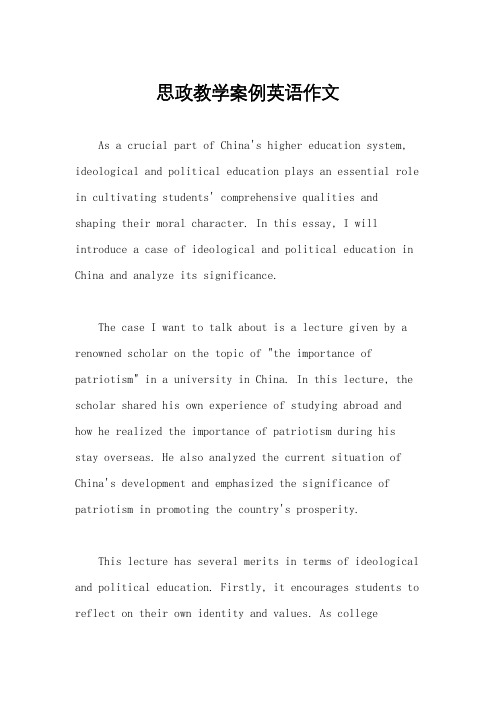
思政教学案例英语作文As a crucial part of China's higher education system, ideological and political education plays an essential role in cultivating students' comprehensive qualities and shaping their moral character. In this essay, I will introduce a case of ideological and political education in China and analyze its significance.The case I want to talk about is a lecture given by a renowned scholar on the topic of "the importance of patriotism" in a university in China. In this lecture, the scholar shared his own experience of studying abroad and how he realized the importance of patriotism during his stay overseas. He also analyzed the current situation of China's development and emphasized the significance of patriotism in promoting the country's prosperity.This lecture has several merits in terms of ideological and political education. Firstly, it encourages students to reflect on their own identity and values. As collegestudents, they are the future of the nation, and it is important for them to have a clear understanding of their role and responsibility in society. Through listening tothe lecture, students could have a deeper understanding of the meaning and significance of patriotism and how itrelates to their personal development.Secondly, the lecture helps to promote a sense of national pride and belonging among students. In recent years, China has made remarkable progress in various fields, and it is important to cultivate a sense of pride and confidence among young people. The lecture reminds students of China's achievements and encourages them to contributeto the country's development.Thirdly, the lecture is a good example of integrating theory with practice. The scholar not only shared his theoretical knowledge but also his personal experience, which makes the lecture more vivid and inspiring. Students could learn from the scholar's experience and apply the knowledge to their own lives.In conclusion, the lecture on the importance of patriotism is an excellent case of ideological andpolitical education in China. It helps to cultivate students' comprehensive qualities, promote national pride and belonging, and integrate theory with practice. It is important for universities to continue to provide high-quality ideological and political education to students, which will contribute to the country's development and the cultivation of future leaders.。
- 1、下载文档前请自行甄别文档内容的完整性,平台不提供额外的编辑、内容补充、找答案等附加服务。
- 2、"仅部分预览"的文档,不可在线预览部分如存在完整性等问题,可反馈申请退款(可完整预览的文档不适用该条件!)。
- 3、如文档侵犯您的权益,请联系客服反馈,我们会尽快为您处理(人工客服工作时间:9:00-18:30)。
这节课充分发挥教学媒体自身的功能和特点,把设备的功能优势转化为教学优势。
它展示了电教媒体与英语作文教学之间的内在关系以及两者之间的相互作用,在不断的磨合中得以巩固和完善,并为英语作作文教学水平的提高注入新的活力。
多媒体教学更有着许多传统教学无法比拟的优势,它能激发学生的学习兴趣,保持学生的学习积极性,综合学生多种感官,提高信息的获取量,扩充课堂知识容量,提高学生口语能力和运用英语的能力。
但不能仅仅把多媒体看作是学
习兴趣的激发者,教师忽略自己的主导地位,变成机器的演示者,避免片面追求课堂容量,要根据学生实际,提高多媒体教学的效率。
根据下列提示, 以“How to keep away from flu”为题,写一篇80词左右的短文, 给人们提出一些有关远离流感的建议.提示:
1、保持睡眠充足,多做运动。
2、多吃蔬菜和水果,多喝水。
3、勤洗手,经常开窗,保证空气流通。
4、如发现身体不适,尽快就医。
……。
